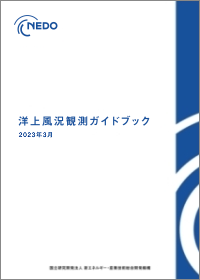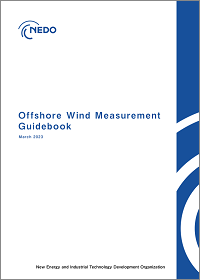洋上風況観測ガイドブック
洋上風力発電所の事業計画の検討においては、事業性を評価するため精度の高い風況データを取得することが重要です。一方で、洋上での風況観測マストの設置には、一般的に地元との調整、許認可手続きや多大なコストを要するため、マストを設置して行う観測の代替として国内外でドップラーライダー等のリモートセンシング技術を活用した観測が行なわれています。しかし、現状でのリモートセンジング技術では風速の乱れ成分の観測や沖合での風速の鉛直分布等を観測する手法は未だ確立されていません。
そこで、国立研究開発法人新エネルギー・産業技術総合開発機構(NEDO)は、上述のようなリモートセンシング技術等を活用した、日本の海域における洋上風況の合理的な観測手法を確立するための技術開発等を青森県むつ小川原港での実観測を基に行い、国内外の最新の知見も参考としながら、洋上風力発電所の事業計画や風車設計に必要な風況観測を実施する実務者に参考となる「洋上風況観測ガイドブック」を取りまとめました。
When considering business plans for offshore wind farms, it is important to obtain accurate wind data in order to assess their feasibility. On the other hand, the installation of wind observation masts at sea generally requires coordination with local authorities, licensing procedures and significant costs. For this reason, observations using remote sensing technologies such as Doppler lidar are being carried out in Japan and abroad as an alternative to mast installation. However, current remote sensing technology has not yet established a method for observing the turbulent intensity of wind speed or the vertical distribution of wind speed relatively far from the coast.
Therefore, New Energy and Industrial Technology Development Organization (NEDO) has developed a technology to establish a rational observation method for offshore wind conditions in Japan, using remote sensing and other technologies, based on actual observations at the port of Mutsu Ogawara in Aomori Prefecture. Using the results of these observations and the latest domestic and international knowledge as reference, “Offshore Wind Observation Guidebook” has been compiled to provide a reference for practitioners who carry out wind observations necessary for project planning and wind turbine design for offshore wind farms.
問い合わせ先
新エネルギー部 風力・海洋グループ
最終更新日:2023年6月23日


